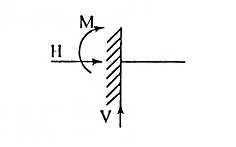Equilibrium of Rigid Bodies Interview Questions and Answers:
1. Define Rigid body
Ans. If the distance between any two particle of a body remains constant, it is called as rigid body.
2. Define Free body diagram
Ans. Free body diagram of a body is the diagram drawn by showing all the external forces and reactions on the body by removing the contact surface.
3. What is meant by equilibrium?
Ans. A body is in equilibrium, if it is either at rest or is moving with a uniform velocity.
4. Define beams.
Ans. Beams are the structural members that are subjected to external forces and moments.
5. What are the type of beams?
Ans.
- Cantilever beam
- Simply Supported beam
- Overhanging beam
- Fixed beam
6. What are the type of loads that can be applied on beams?
Ans.
- Point load (or) concentrated load
- Uniformly distributed load (UDL)
- Uniformly varying load (UVL)
7. Mention the type of supports.
Ans.
- Roller support
- Hinged or pinned support
- Fixed support
8. Draw the fixed support and its reactions.
Ans.

9. What is statically determinate structure?
Ans. A structure under static condition satisfies the equations ΣH = 0, ΣV = 0 and ΣM = 0, Then it is called as statically determinate structure.
10. Differentiate between beam and frame
Ans. Beam is a horizontal structural member that carries load. Frame is a rigid structure made of three or more members welded, riveted or hinged together.
11. State Lami’s theorem.
Ans. If three forces are acting at a point are in equilibrium, each force is proportional to the sine of the angle between the other two forces.
12. What are the steps to be followed in drawing free body diagram?
Ans.
- Isolate the body from all other forces.
- Indicate the external forces on the free body.
- The magnitudes and directions of the known external forces should be mentioned.
- The reactions exerted by the supports on the body should be clearly indicated.
- Mark the dimensions in the free body diagram clearly.
13. Draw the free body diagram of the following system.

14. Define equilibrant?
Ans. It is defined as the force which brings the system of forces into equilibrium. It is equal to the resultant force but in opposite direction.